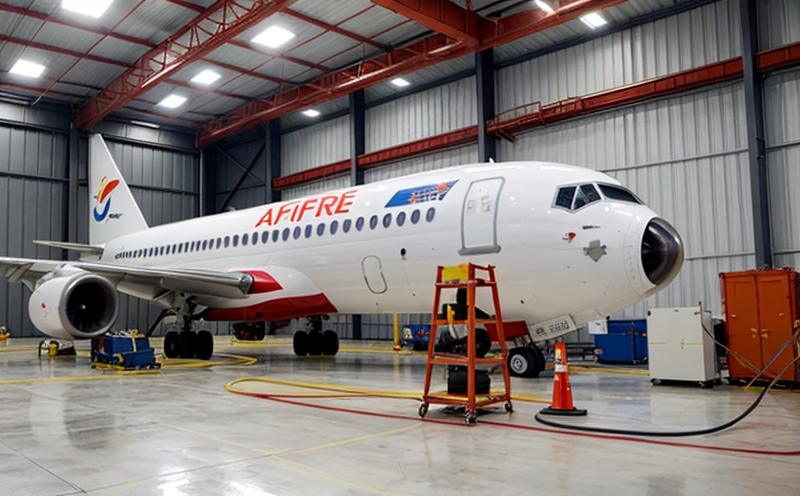Boeing BSS 7239 Flammability Testing of Aircraft Seats
The Boeing BSS 7239 standard is a critical pillar in ensuring that aircraft seats meet the stringent fire safety requirements set forth by aviation authorities. This testing procedure evaluates the flammability properties of seat materials used in commercial and military aircraft, aiming to minimize the risk of fire during flight operations.
Aerospace fire incidents can have devastating consequences not only for passengers but also for crew members and the integrity of the aircraft itself. By adhering to Boeing BSS 7239, manufacturers and suppliers contribute significantly to enhancing passenger safety and operational reliability. This testing ensures that seat materials are resistant to ignition under various environmental conditions, including high humidity, low oxygen levels, and the presence of contaminants such as dust or smoke.
The test procedure involves subjecting a representative sample of the seat material to controlled flame exposure in accordance with specific parameters outlined in Boeing BSS 7239. The objective is to measure both the rate at which flames spread across the specimen surface and the amount of heat released during combustion. These metrics provide critical data that helps manufacturers optimize their designs while ensuring compliance with industry standards.
Accurate sampling techniques are essential for obtaining reliable test results, as they directly influence the validity of subsequent analyses. In practice, this means cutting representative pieces from larger seat assemblies or individual components like cushions and upholstery fabrics. Proper sample preparation ensures consistency across multiple tests, allowing for meaningful comparisons between different materials or batches.
The testing apparatus used in accordance with Boeing BSS 7239 includes specialized equipment designed to replicate real-world conditions as closely as possible. This typically involves a combustion chamber equipped with precise temperature and humidity controls, along with sensors capable of measuring key parameters such as flame intensity, smoke density, and gas emissions.
Following the completion of each test run, detailed reports are generated summarizing all relevant findings. These documents serve multiple purposes, including internal quality assurance, regulatory submissions, and customer communications regarding product performance relative to specified thresholds.
To ensure accurate and repeatable results, it is crucial that laboratories conducting Boeing BSS 7239 testing follow strict protocols throughout every stage of the process—from initial sample receipt through final report generation. Compliance with these procedures guarantees consistent outcomes regardless of who performs them or where they take place around the globe.
Understanding the broader implications of this testing underscores its importance within the larger context of aerospace safety initiatives aimed at protecting lives and property alike. As technology continues to evolve, so too must our understanding of how best to mitigate risks associated with fire hazards on board aircraft. Through rigorous adherence to standards like Boeing BSS 7239, we can continue advancing towards safer skies for all travelers.
Applied Standards
In addition to Boeing BSS 7239, several other international and regional standards also play important roles in shaping fire safety requirements for aircraft seating. Key among these are:
- American Society for Testing Materials (ASTM) D6413-05 - This American standard provides guidance on testing the flammability of materials intended to be used in aviation interiors.
- International Organization for Standardization (ISO) 21978 - ISO standards offer additional perspectives on fire performance, particularly focusing on the behavior of plastics and composites under extreme thermal conditions.
- Aerospace Industries Association of Europe (AIA) P-8004 - This document specifies requirements for flame spread and heat release rates in various types of aircraft cabin materials.
By incorporating elements from these diverse sources into their testing protocols, organizations like Boeing ensure that they remain at the forefront of safety innovation while maintaining compatibility with global regulatory frameworks.
Scope and Methodology
The scope of Boeing BSS 7239 encompasses all aspects related to evaluating seat materials for use in commercial and military aircraft. Specifically, this includes:
- Testing for flame propagation characteristics
- Evaluation of heat release rates
- Assessment of smoke production capabilities
- Determination of ignition resistance properties
- Incorporation of environmental factors such as humidity and oxygen concentration
The methodology employed in conducting these tests follows a series of well-defined steps aimed at producing consistent, reproducible results. Initially, samples are prepared according to established guidelines ensuring uniformity across all specimens being tested. Once ready, they undergo exposure to controlled flame sources within the designated combustion chamber.
During this process, various instruments continuously monitor and record numerous parameters including temperature, pressure, flow rate, and gas composition. Afterward, analysis of collected data allows determination of whether or not each sample meets specified criteria outlined in Boeing BSS 7239.
A key aspect of the methodology involves replicating realistic operating conditions as closely as possible during testing. For instance, seat covers may be exposed to relative humidity levels found inside typical commercial aircraft cabins (typically around 15-20%). Similarly, oxygen concentrations are adjusted to reflect those present in pressurized environments (~19% O₂).
By incorporating these real-world variables into the test setup, manufacturers gain valuable insights into how their products will perform under actual service conditions. This information helps inform design decisions that prioritize both passenger safety and comfort.
International Acceptance and Recognition
The Boeing BSS 7239 standard enjoys broad acceptance across multiple jurisdictions due to its rigorous nature and alignment with global safety objectives. Countries that have formally recognized or adopted this standard include:
- United States of America (FAA)
- European Union (EASA)
- Canada
- Australia
- New Zealand
In addition to national authorities, international organizations such as the International Civil Aviation Organization (ICAO) and the International Air Transport Association (IATA) have endorsed Boeing BSS 7239 as part of their broader efforts to enhance aviation safety worldwide. This widespread recognition underscores its significance in maintaining consistent quality standards across diverse operational environments.





